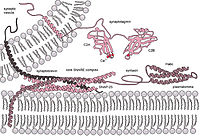
Photo from wikipedia
Protein folding has been posing challenges for molecular simulation for decades. Implicit solvent models are sought as routes to increase the capability of simulation, with trade-offs between computational speed and… Click to show full abstract
Protein folding has been posing challenges for molecular simulation for decades. Implicit solvent models are sought as routes to increase the capability of simulation, with trade-offs between computational speed and accuracy. Here, we systematically investigate the folding of a variety of α-helix bundle proteins ranging in size from 46 to 102 amino acids using a state-of-the-art force field and an implicit solvent model. The accurate all-atom simulated folding is enabled for six proteins, including for the first time a successful folding of protein with >100 amino acids in implicit solvent. The detailed free-energy landscape analysis sheds light on a set of general principles underlying the folding of α-helix bundle proteins, suggesting a hybrid framework/nucleation-condensation mechanism favorably adopted in implicit solvent condition. The similarities and discrepancies of the folding pathways measured among the present implicit solvent simulations and previously reported experiments and explicit solvent simulations are deeply analyzed, providing quantitative assessment for the availability and limitation of implicit solvent simulation in exploring the folding transition of large-size proteins.
Journal Title: Journal of chemical theory and computation
Year Published: 2017
Link to full text (if available)
Share on Social Media: Sign Up to like & get
recommendations!